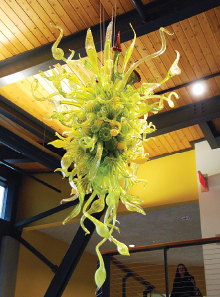Awaken Your Senses at Spring’s Height at Atlanta’s Botanical Garden
Abstract
A short cab ride away from the APA Annual Meeting but well worth the side trip lies the home of thousands of extraordinary flowers, plants, trees, and even a few familiar vegetables.
The Atlanta Botanical Garden, at 1345 Piedmont Avenue, features many collections of plants from around the world—from the bright orchids and neotropical blueberries of the cloud forests of the Andes Mountains in South America to succulent collections native to Madagascar.

Among much real greenery, a friendly copper frog by artist Beau Smith invites visitors to the Atlanta Botanical Garden to take a bit of a breather beside him on the bench.
The Tropical Rotunda includes garden habitats from lowland tropical forests in Central America, Central Africa, Southern Mexico, and Southeast Asia. There are also selections of idiosyncratic island environments from the Seychelles, New Zealand, New Guinea, New Caledonia, and the Comoros Islands.
The garden features some truly exotic plants, like the nepenthes, originally from South Asia and Australia. This carnivorous plant dines on insects and the occasional inattentive small rodent who slip into the large cup that characterizes the flower after sipping nectar produced by the plant. There, they are digested.
In addition to offering visitors a chance to see flowers from around the world, the Botanical Garden works to conserve and restore rare and threatened plant species native to the Southeastern United States. The garden’s Tissue Culture Lab uses cloning and other techniques to propagate plants like native orchids and trillium, which can later be replanted in their native habitats. Efforts by garden staff and volunteers, for example, have helped repopulate the nearly vanished Cigar Orchid in Florida’s Fakahatchee Strand State Preserve.

The Nepenthes Chandelier by glass artist Dale Chihuly hanging by the entrance of the Atlanta Botanical Garden was inspired by the insect-eating plant whose name it bears. Many more of Chihuly’s brightly colored glass creations will be on display in May.
Not all plants are simply a feast for the eyes. The Botanical Garden’s Edible Garden reminds visitors that what looks good might also taste good.
The adjacent Outdoor Kitchen features Atlanta’s top chefs, who offer cooking classes on Saturdays and Sundays at noon, 1 p.m., and 2 p.m., showcasing seasonal recipes using ingredients harvested from the Edible Garden. Any harvested food not used in educational programs is donated to local charities.
Lunch is available at the Cafȳ at Linton’s in the Garden, supervised by Chef Linton Hopkins, a James Beard Award winner and popular Atlanta restaurateur. The menu is based on fresh, local ingredients inspired by the Garden.
Beyond its own leafy wonders, the Botanical Garden will feature a major exhibit of the works of renowned American glassblower Dale Chihuly during the APA Annual Meeting. Abstract but clearly reminiscent of the natural world, some of these large glass sculptures have already been installed, but many more will be in place throughout the gardens in May.
To give visitors an opportunity to explore the 20 installations in the light of evening, the Botanical Garden will offer extended hours on Wednesdays through Sundays in May. ■
For more information, visit the Atlanta Botanical Garden website.



